Stonehenge is a prehistoric stone circle in Wiltshire, England, built around 2500 BC. It's a site of debate and speculation about its purpose, with theories ranging from ceremonial to astronomical observations. Visitors can explore the monument, exhibitions, and learn about its construction, which involved transporting massive stones over 150 miles from Wales using unknown methods.
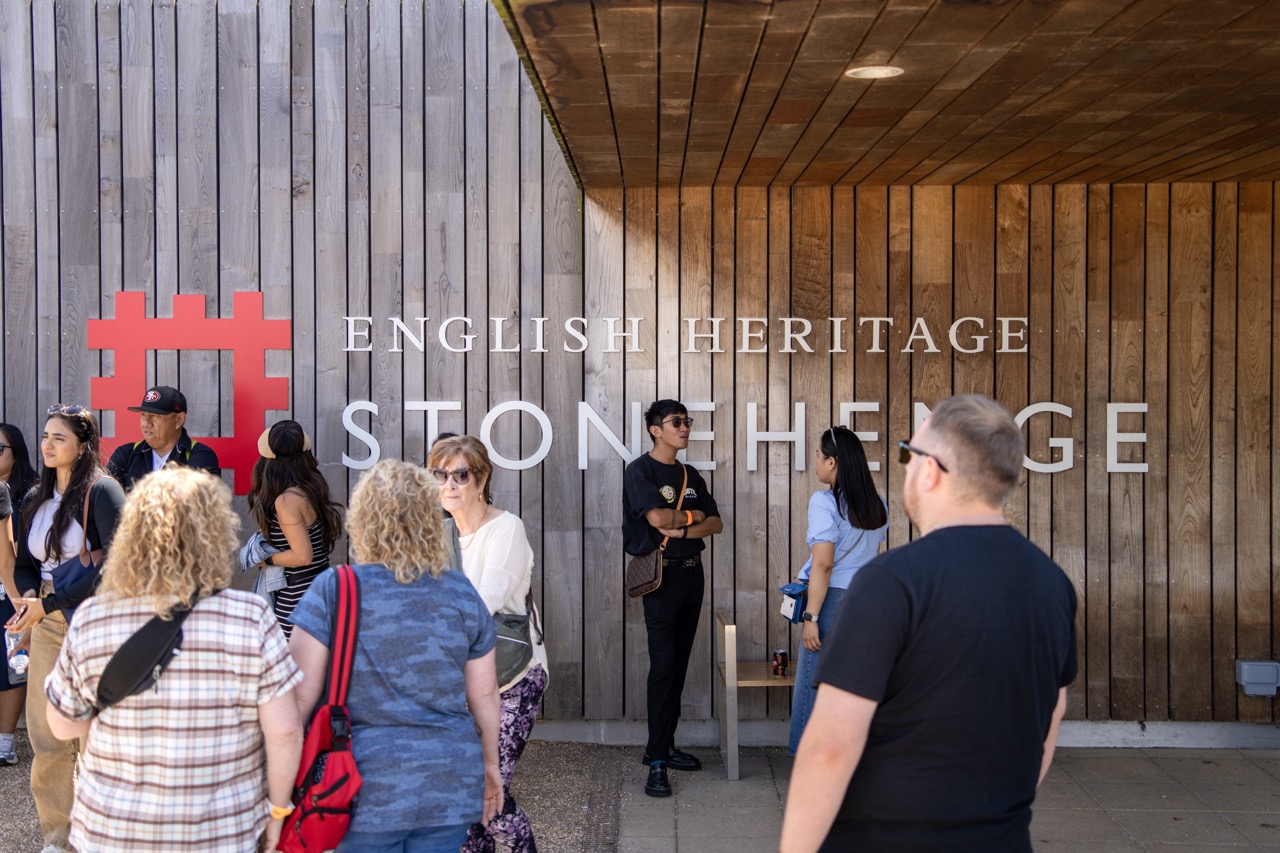

Title: The Stonehenge Experience: Queue Edition
Rating: 6/10
The scene captures the modern reality of visiting ancient wonders: people gathered outside the English Heritage Stonehenge Visitor Centre. The large white letters proudly announce the location against the warm, vertically-planked wooden facade, punctuated by a striking red block logo that hints at the site's historic architecture. A diverse group of tourists are milling about, some looking at the signs, others in conversation, their casual attire suggesting a relaxed day out under bright sun. The mood is typical of a busy tourist spot – a blend of anticipation and casual waiting. The ground is a light, practical surface, contrasting slightly with the rich tones of the wood. This is documentary style, showing the visitor experience rather than the monument itself, offering a glimpse into the logistical side of exploring history.
Photographically, this shot uses the prominent English Heritage signage as its focal point, nicely positioned against the textured wooden facade which provides a strong visual backdrop. However, the composition is somewhat hindered by the classic 'backs of people' dilemma in the foreground, a common challenge at popular sites. The bright, high sun typical of midday delivers plenty of light but creates rather harsh shadows, flattening some areas and potentially making faces less flattering – a classic case where diffused light would be a photographer's friend. The angle gives a good sense of the entrance structure. It's a candid, documentary-style shot capturing the reality of visitor flow; useful for documentation, perhaps less so for artistic impact, unless your aim is to perfectly capture the feeling of "Oh, right, I'm stuck behind Brenda from accounting again." Still, it serves its purpose in showing the context of the visitor centre.
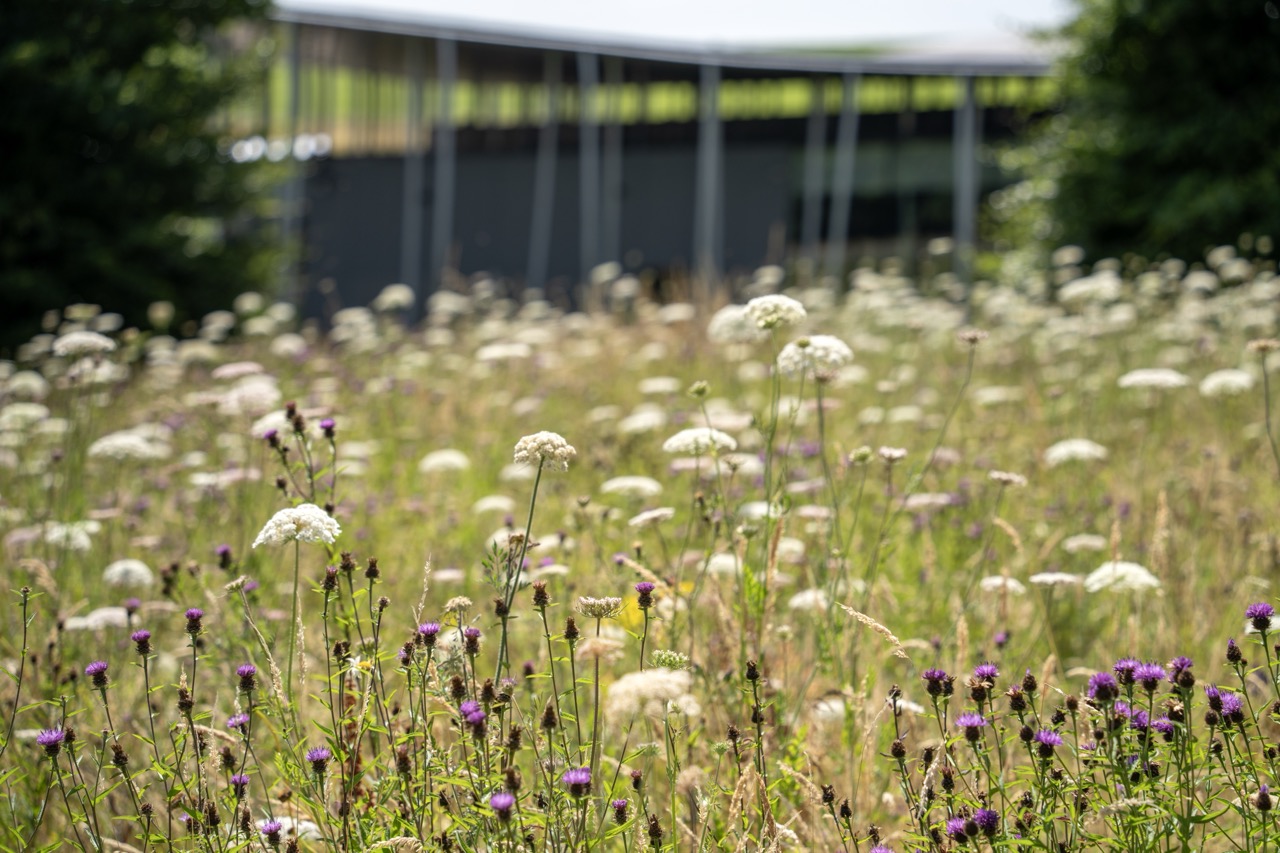

Meadow Dreams and Blurred Ambitions
Subject Rating: 8/10
Ah, the classic "foreground flowers stealing the show" shot! Here we have a lovely meadow bursting with wildflowers – mostly delicate white Queen Anne's Lace and some vibrant purple thistles – all bathed in a gentle, golden light. The focus is razor-sharp on the blooms in the immediate foreground, creating a lush, painterly bokeh effect that makes the rest of the world just melt away. It's a peaceful, summery scene that feels natural and inviting, like the kind of place you'd want to wander through, or at least photograph from a safe distance (those thistles look spiky!). What's happening? Just nature doing its beautiful thing, thriving in what appears to be a cultivated natural space, perhaps part of the grounds of the intriguing, albeit anonymous, structure lurking in the background.
From a photography perspective, this image nails the shallow depth of field for maximum dreamy impact. The composition places the most prominent flowers slightly off-center, adding a touch of dynamism, while the repetition of the white blooms creates a nice visual rhythm leading the eye deeper into the frame. The lighting is soft and warm, perfect for highlighting the textures of the flowers and grasses without harsh shadows. The color palette is dominated by natural greens and earth tones, accented by the pops of white and purple, giving it an authentic, earthy feel. The background, a modern building with sleek lines and glass, is rendered almost abstract by the blur – a building with an identity crisis, perhaps? "Am I architecture? Or just a fuzzy backdrop for pretty weeds?" Regardless, it serves its purpose, providing context and a hint of human presence without distracting from the floral protagonists. A solid execution of a popular nature photography technique.
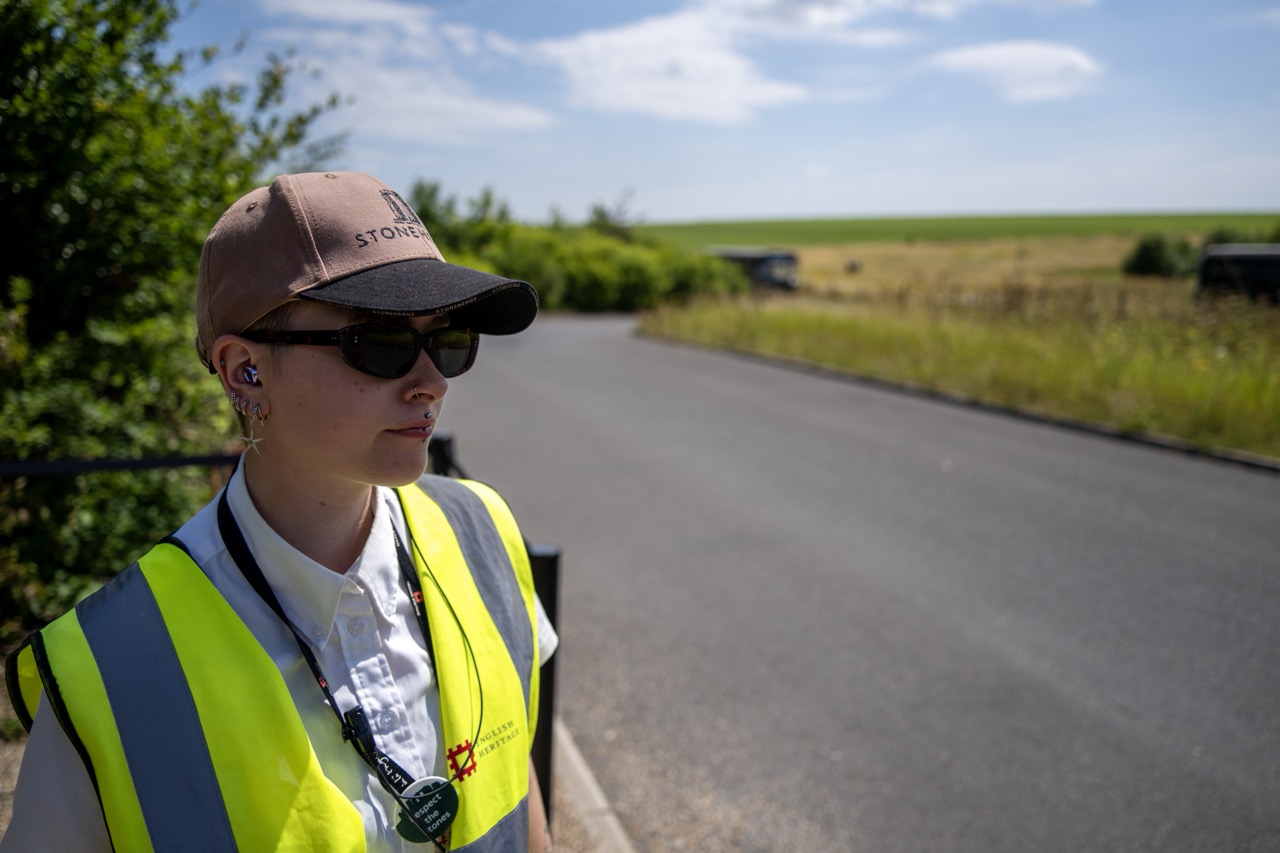

Guard Duty, Make It Fashion
Rating: 7/10
Here we have a portrait of a dedicated individual, perhaps guarding the sacred gravel of a parking lot or directing wayward tourists who mistakenly believe Stonehenge accepts drive-thru orders. Our subject, rated a respectable 7/10 for sheer character and sartorial bravery, stands resolute in a high-visibility vest that practically screams 'safety first, style... maybe fourth?'. Topping off the look is a 'Stonehenge' cap, a fashion statement that says "I'm here for ancient rocks, but I'm also prepared for unexpected drizzle." Adorned with an array of piercings and cool sunglasses, they possess an air of quiet authority mixed with a 'don't mess with my cones' vibe. The mood is a blend of official duty and understated personal flair on a bright, sunny day.
From a photographic standpoint, the composition cleverly places the subject off-center using the rule of thirds, allowing the background's curving road and blurry field to provide context without distracting. The lighting is classic bright daylight, giving the scene a natural, if slightly harsh, feel with strong highlights on the vest and shadows under the brim of the cap. The shallow depth of field is employed effectively, sharply focusing on our stoic guard while blurring the mundane background into pleasant bokeh, drawing all attention to the details of their face, cap, and rather intriguing lanyard with its partly visible badge, perhaps offering sage advice like "Respect the tones." It's a simple yet effective capture of a unique person in a specific environment, highlighting the blend of personal identity and official role.
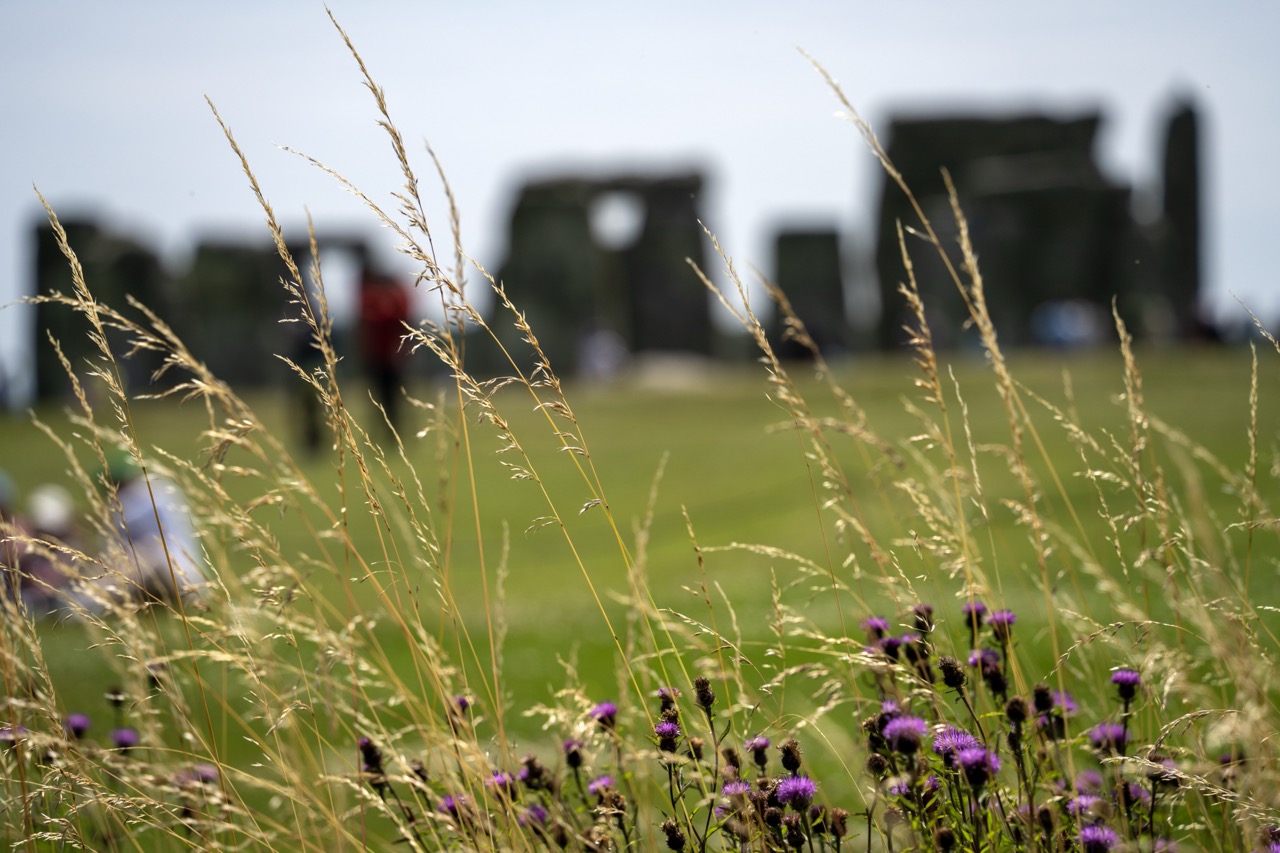

Grass Takes Center Stage: Stonehenge Plays Second Fiddle
Subject Rating: 6/10 | Overall Photo Rating: 7.5/10
Ah, the majestic, world-renowned... grass! Here we have a stunning portrait of some exceptionally photogenic blades of grass, proudly catching the light and demanding your full attention. Seriously, the sharpness and detail on these golden strands are immaculate, a true testament to... well, excellent grass maintenance, perhaps? Below them, a smattering of charming purple thistles add a pop of color, bravely competing for the spotlight with the towering grass. The photographer has employed a wonderfully shallow depth of field, ensuring that anything beyond this verdant curtain becomes a lovely, soft, indistinct blur. And what exactly *is* that blurry blobbery in the background, you ask? Oh, just some old rocks. Apparently, they're quite famous. You can just about make out the vague shapes of the Stonehenge sarsens and trilithons, looking like someone's smudged charcoal drawing of history. There are also a few blurry humanoids milling about, presumably also trying to figure out why they can't see the stones properly.
This composition makes a bold statement: nature is right here, in front of you, perhaps more compelling than distant, dusty history. The lighting, hitting the grass from the side or back, creates a beautiful shimmer on the seed heads, drawing the eye precisely where the photographer intended – away from the main attraction. The color palette is dominated by the greens and yellows of the foreground, grounding the image in the present, while the muted background feels almost like an afterthought. While technically proficient in its use of focus and depth of field to create separation, one can't help but wonder if the photographer accidentally left their glasses at home or is perhaps secretly campaigning for grass to be recognized as a UNESCO World Heritage site itself. A well-executed shot focusing on the often-overlooked immediate surroundings, even if it hilariously obscures the subject most people came to see.
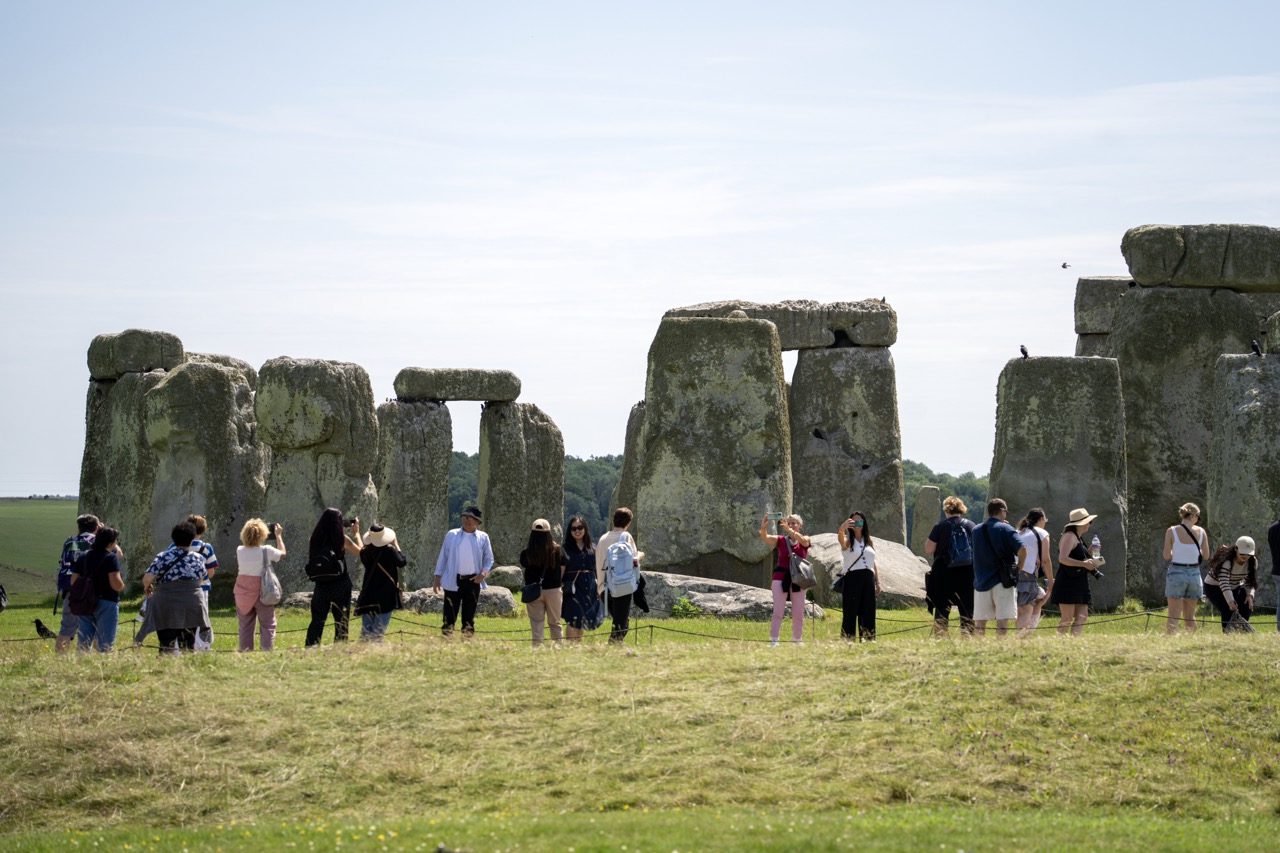

Stonehenge: The Great Wall of Tourists Edition
Rating: 6/10
On a bright, sunny day, a crowd of tourists gathers at the edge of the iconic Stonehenge site. The mood is one of relaxed exploration, with visitors taking in the ancient stones, snapping photos, and chatting amongst themselves. They form a distinct line, maintaining a polite distance from the monument, which stands majestically in the background. The sun casts strong light, highlighting the textures of the massive rocks and illuminating the vibrant green grass in the foreground. Birds perch atop the stones, perhaps pondering the strange rituals of these bipedal creatures with their glowing rectangles. It's a scene quintessential to visiting a world-famous landmark – a blend of awe at the history and the shared experience of being a tourist among many.
From a photographer's perspective, this image adopts a straightforward, documentary style, prioritizing clarity over artistic abstraction. The composition places the line of people prominently in the mid-ground, almost acting as a horizontal barrier separating the viewer from the main subject, the Stonehenge stones. While this effectively captures the visitor experience, it somewhat crowds the frame and detracts from the monument's scale. The lighting is typical midday sun – bright and clear, but lacking the drama and long shadows that could enhance the monument's ancient mystique. The subject matter is compelling due to the historical significance, but the execution is a standard tourist-eye view. The distant flat fields and hazy tree line in the background provide context to the open landscape, but the focus remains firmly on the interaction between the visitors and the rocks. A solid capture of 'Stonehenge: The Queue Edition', earning a 6/10 for its honest portrayal of the scene, though a more creative angle or different lighting could elevate it.
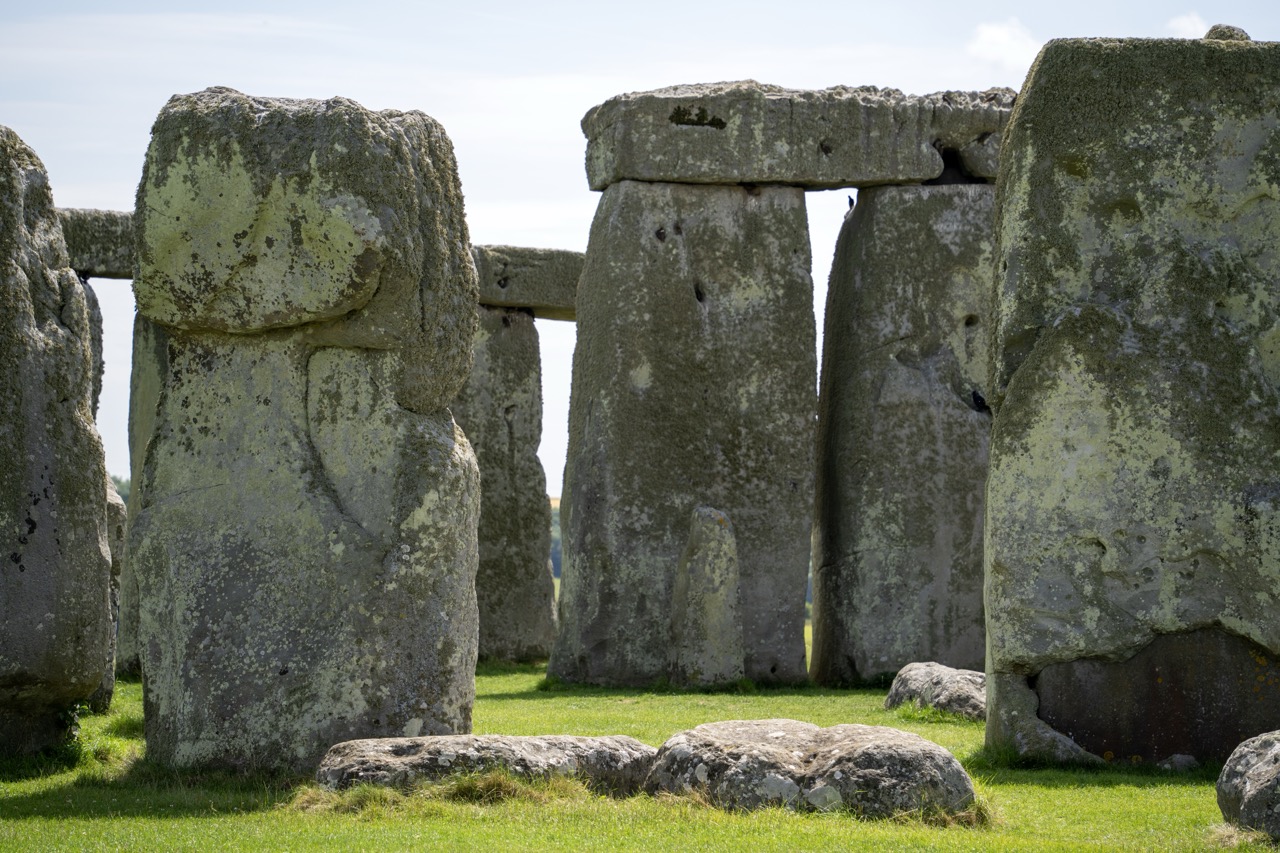

Ancient Guardians
Rating: 9/10
Alright, let's dive into this timeless assembly of rocks. Subject: The majestic and deeply patient stones of Stonehenge, earning a well-deserved 9/10 for their enduring presence and ability to just... stand there for millennia. What's happening? Not a whole lot, to be honest. They're primarily just standing around, showing off their impressive scale and the fashionable green-grey lichen that's taken up residence, giving them a lovely mottled texture. The mood is ancient, quiet, and perhaps a little bit mysterious, like they're waiting for something or just finished telling a really long, boring story about the Bronze Age. Composition-wise, the shot focuses tightly on the monumental size and rough surface of the stones in the foreground and middle ground, highlighted by soft, diffuse daylight that avoids harsh shadows and accentuates every crack and patch of growth. It gives you a great sense of their sheer mass and the intricate details carved by time and lichen.
The color palette here is earthy and subdued – lots of grey stone, vibrant green grass, and a pale sky, fitting for the British countryside. The background is a subtle hint of the world beyond, seen through the gaps between the uprights, reminding us this isn't just a pile of rocks, but a deliberate structure within a landscape. The style leans towards a classic, almost documentary approach, focusing on the subject's physical reality rather than dramatic flair. While these silent sentinels aren't performing any acrobatic feats, the image successfully conveys their immense weight and the sense of history embedded in every stone. The smaller rocks scattered on the grass add another layer of detail, perhaps fallen pieces or just companions to the giants, reinforcing the natural, weathered state of the site. It's a solid capture that makes you appreciate the effort of building such a place, even if the original purpose remains a topic of rather serious historical debate.
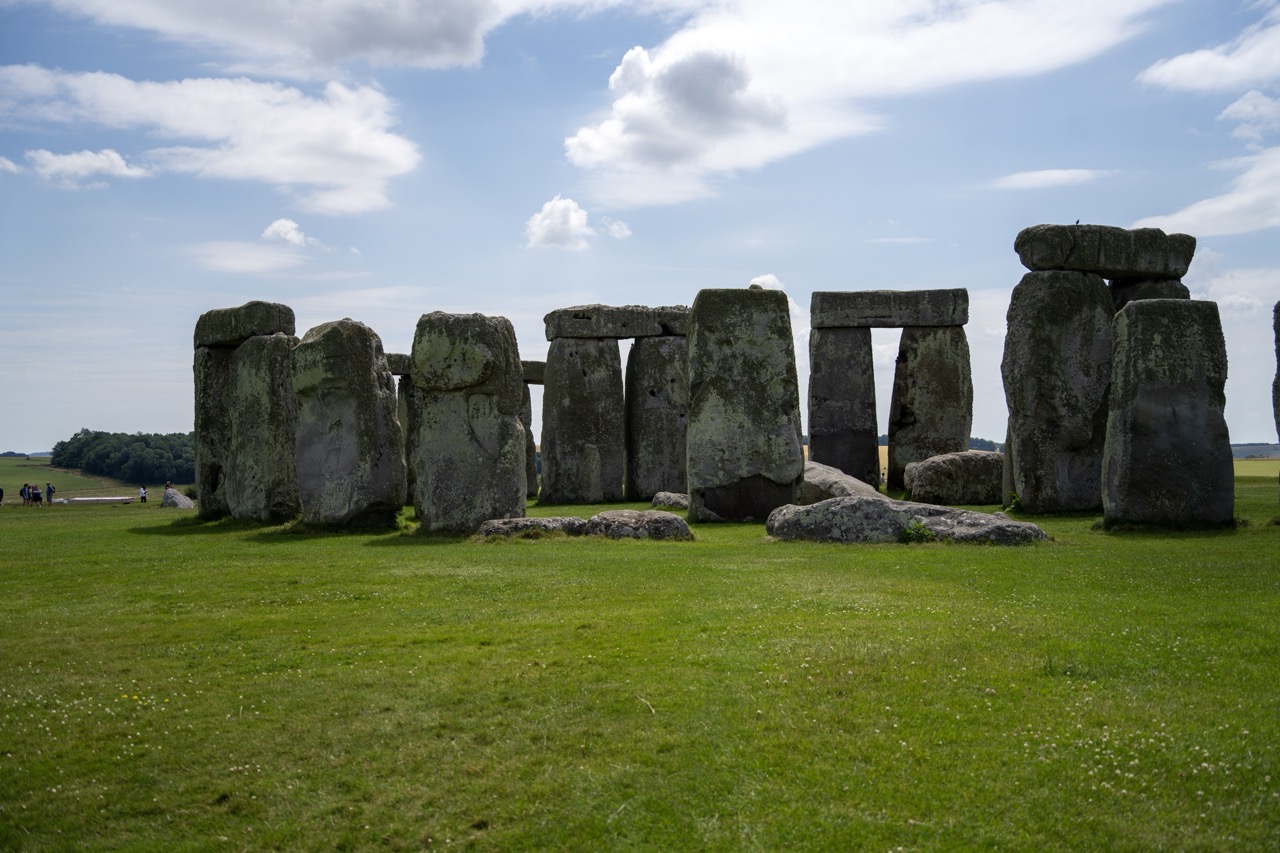

Title: Standing Stones and Slightly Less Standing Tourists
Rating: Subject: 9/10 (A classic for a reason, even if it's been shot a million times)
Ah, Stonehenge! The ultimate "rocks in a field" photo opportunity, captured here in its familiar, imposing glory. A collection of giant, moss-covered sarsen stones stand sentinel, some topped with hefty capstones, looking every bit the ancient monument they are. The mood is one of quiet, enduring mystery, punctuated slightly by the faint presence of modern humans exploring the perimeter in the background – perhaps pondering celestial alignments, or more likely, just looking for the snack bar. The main subjects dominate the middle ground, anchored by an expansive patch of verdant green grass that seems to stretch on forever towards a line of distant trees under a pleasantly cloudy, but not overly dramatic, sky.
From a photographic perspective, the composition is straightforward and effective, placing the iconic stones centre-stage against the horizon line. The lighting is typical of a UK cloudy day – soft, diffuse, and free of harsh shadows, which is great for detail but perhaps lacks a bit of dramatic punch. The colour palette is dominated by the earthy greens of the grass and the muted greys of the stone, grounded by the blue and white tones of the sky. It's a clean, documentary style shot that clearly presents the subject. While technically sound and a good record, the challenge with photographing Stonehenge is finding that unique perspective or lighting condition to elevate it beyond the standard postcard view. Still, these old rocks hold their own, demanding attention simply by existing.
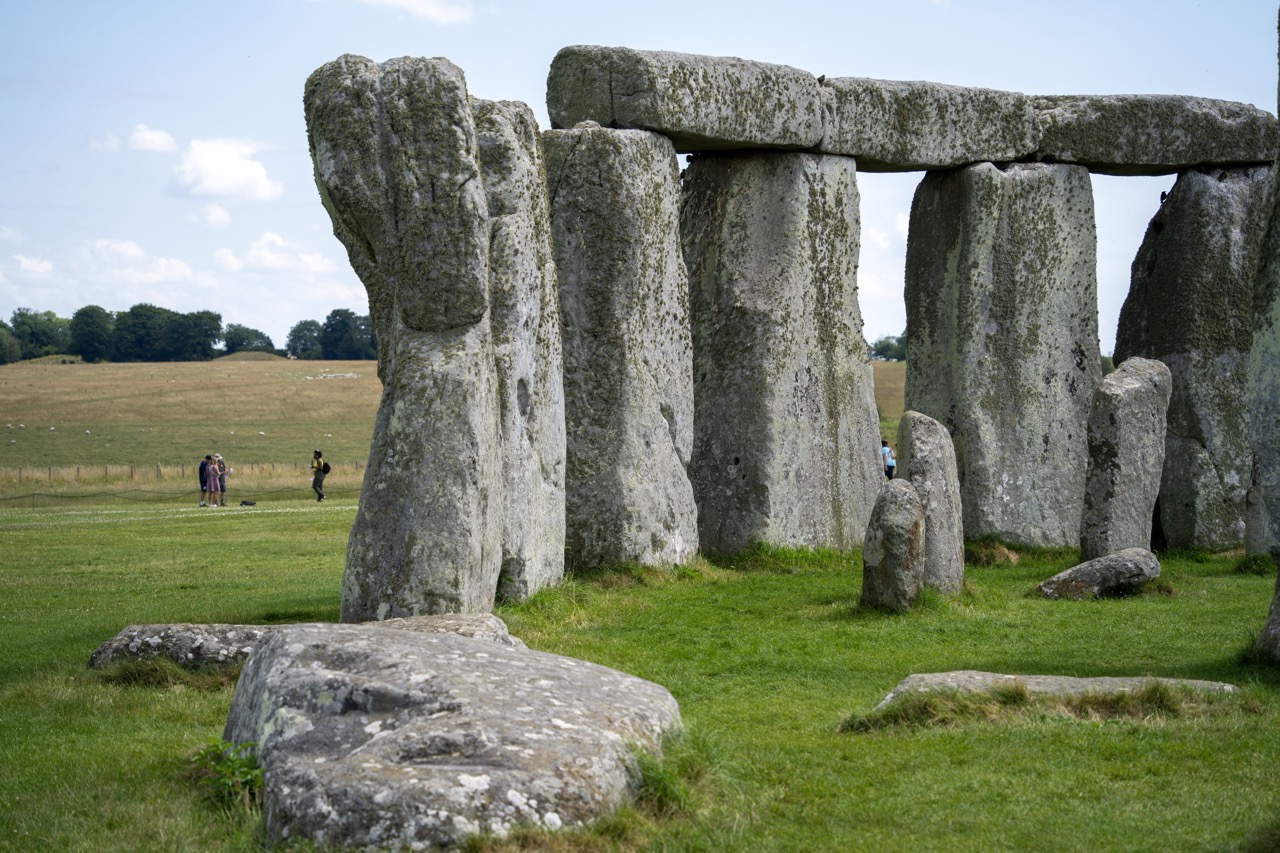

Stonehenge: More Grey Than Grisly
Subject Rating: 9/10
Here we have the classic view of Stonehenge, arguably the most famous pile of rocks in the world. What's happening is the age-old tradition of humans standing around giant stones, trying to comprehend *why* someone bothered moving them. The mood is a blend of ancient mystery and modern tourism; you can almost hear the distant click of cameras and polite murmurs. The pertinent objects are, naturally, the massive Sarsen stones forming the iconic trilithons, some smaller, more humble stones scattered about (perhaps they didn't make the final cut for the main circle), and a few resilient tourists braving the elements and the fence line. The background stretches out into classic English countryside – rolling green fields, distant treelines, and a sky that looks ready to deliver either sunshine or drizzle at any moment, perfectly complementing the grey grandeur of the stones.
From a photographic standpoint, this is a pretty straightforward documentary shot. The composition places the main structure off-center, attempting to include a foreground stone for depth, which is a nice touch, though its prominent placement almost distracts. Lighting is standard bright daylight, functional for showing detail but lacking the dramatic punch that sunrise or sunset would bring to these ancient forms – perhaps the photographer missed the golden hour or was simply there at a convenient time, as tourists often are. Color is muted but natural, dominated by the greys and greens of the landscape. The style leans towards capturing the scene as it is, a snapshot of a moment at a legendary site. It's a solid representation, but lacks the artistic flair that truly elevates a photo of such an iconic subject. The challenge of photographing Stonehenge, of course, is finding a new perspective that hasn't been shot a million times while avoiding accidental selfies in the background. This shot manages the latter, at least.
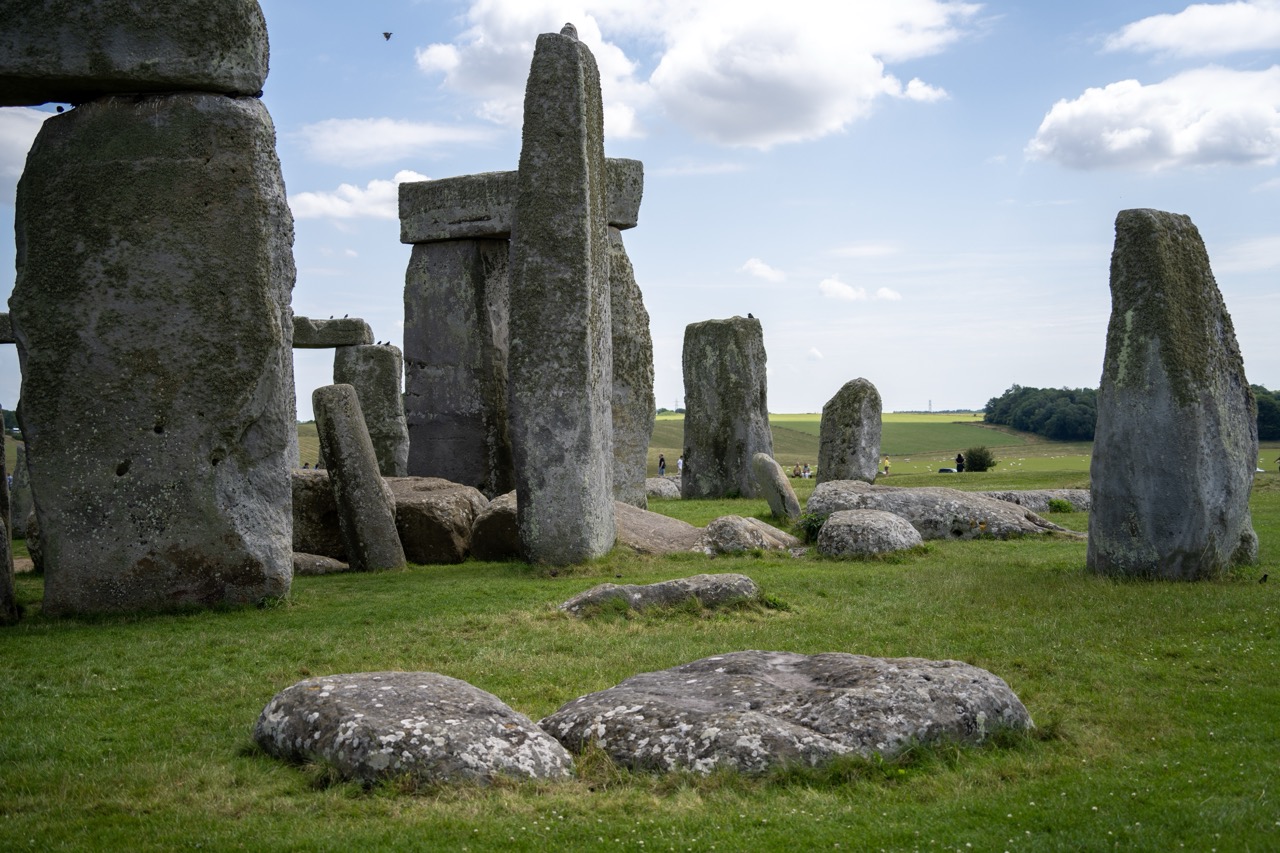

Ancient Heavy Metal
Subject Rating: 9/10
Ah, Stonehenge. The ultimate prehistoric photo op, where giant rocks have been expertly 'arranged' to confound future archaeologists and provide rather challenging compositional puzzles for photographers. This shot captures the iconic megaliths basking under a slightly dramatic, cloudy sky. What's happening is pretty standard for the site: stoic stones stand guard while tiny human ants mill about in the distance, likely pondering the age-old question: "But how did they move them?" or perhaps, "Where's the gift shop?". The mood is a blend of ancient awe and slightly domesticated historical tourism. It’s a place that whispers of forgotten rituals, astronomical alignments, and the sheer brute force of our ancestors, while also clearly marking the boundaries where you, the modern visitor, absolutely cannot step.
From a photographic perspective, this image leverages a low angle to emphasize the scale and texture of the sarsen stones in the foreground and mid-ground. The composition uses the looming verticality of the standing stones against the horizontal sweep of the Wiltshire landscape. The lighting is diffused, courtesy of those obliging clouds, which softens shadows and brings out the gritty detail and lichen-covered surfaces of the stones. However, the low angle does mean a significant portion of the frame is taken up by grass and foreground rocks, slightly competing with the main structure. The color palette is dominated by earthy greens and greys, fitting for the ancient subject matter, with the bright sky adding a bit of visual relief. Overall, it's a solid portrayal of the site, capturing its imposing presence, even if one might wish for slightly fewer foreground rocks or a composition that felt a touch less like tripping over ancient debris.
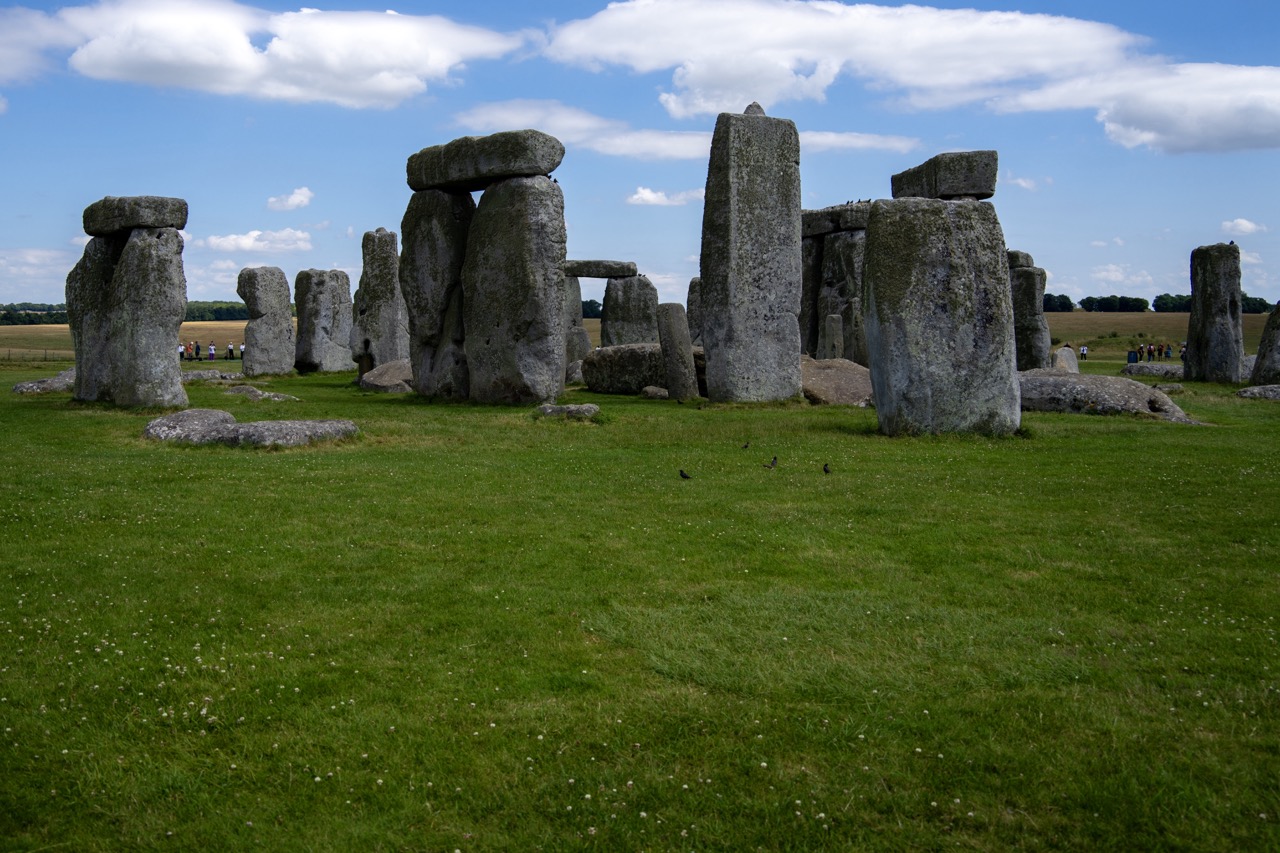

Stonehenge: An Awkward Family Photo from 4000 BCE
Subject Rating: 9/10
Ah, Stonehenge. The original 'pile of rocks' that somehow draws millions. Here we see the iconic Neolithic selfie-background, standing stoically in a vast, flat field under a classic partly cloudy English sky. The massive sarsen stones, weathered and grey, dominate the foreground and mid-ground, arranged in their circular (or rather, horseshoe-shaped) formation. The lush, vibrant green grass dotted with tiny white flowers provides a striking contrast to the ancient stones, making it clear that while the rocks have been here forever, someone definitely mows the lawn. In the distance, beyond the hallowed circle, are fields stretching towards a distant tree line and horizon, dotted with tiny figures of fellow tourists, proving that even millennia-old mysteries aren't immune to peak season crowds. The mood is a blend of historical awe and the slightly anticlimactic reality of visiting a popular landmark; the stones themselves are majestic, but the distant crowds and the well-manicured setting bring it firmly into the present day.
From a photographic standpoint, this shot is a straightforward documentary approach. The composition places the main structure centrally, capturing the scale and arrangement of the remaining stones. The perspective is slightly low, emphasizing the height of the uprights. The lighting is bright and natural, casting relatively soft shadows and revealing the texture of the stones and the richness of the grass. Color saturation is decent, showcasing the earthy tones and the bright sky. It's a classic wide-angle view, effective for showing the entire site within its landscape context. While it gets the job done, showing the 'what and where' effectively, there's not much stylistic flair or unique perspective. It's the standard postcard shot, perhaps lacking the drama or atmosphere a dawn/dusk shot or a tighter composition could offer. The small birds in the foreground are a charming, if unintentional, addition, adding a touch of life to the scene, perhaps contemplating the age-old question: "Why did they build this here, and more importantly, is there food?"
Loading map...